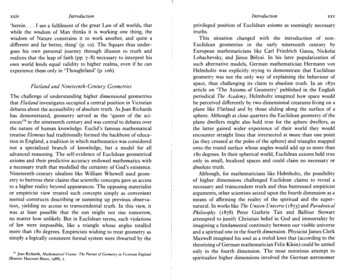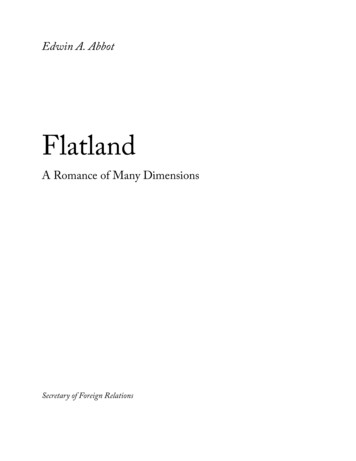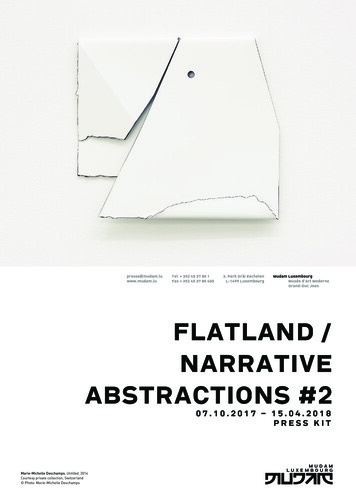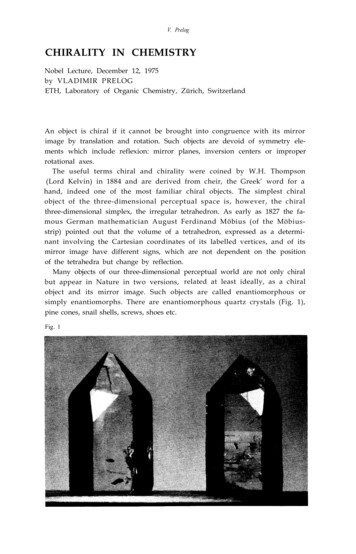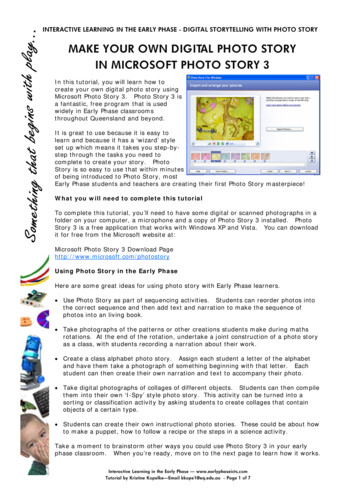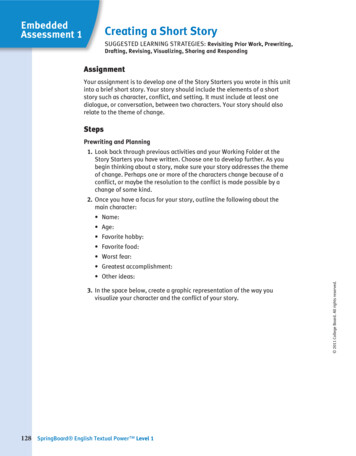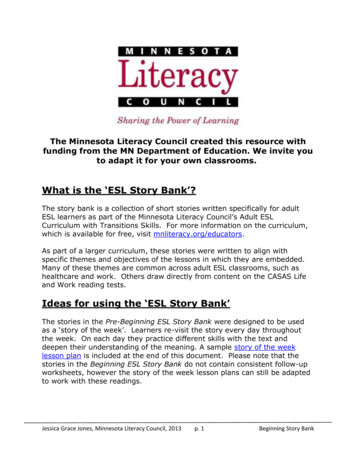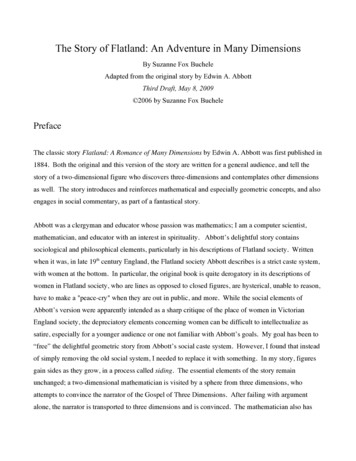
Transcription
The Story of Flatland: An Adventure in Many DimensionsBy Suzanne Fox BucheleAdapted from the original story by Edwin A. AbbottThird Draft, May 8, 2009 2006 by Suzanne Fox BuchelePrefaceThe classic story Flatland: A Romance of Many Dimensions by Edwin A. Abbott was first published in1884. Both the original and this version of the story are written for a general audience, and tell thestory of a two-dimensional figure who discovers three-dimensions and contemplates other dimensionsas well. The story introduces and reinforces mathematical and especially geometric concepts, and alsoengages in social commentary, as part of a fantastical story.Abbott was a clergyman and educator whose passion was mathematics; I am a computer scientist,mathematician, and educator with an interest in spirituality. Abbott’s delightful story containssociological and philosophical elements, particularly in his descriptions of Flatland society. Writtenwhen it was, in late 19th century England, the Flatland society Abbott describes is a strict caste system,with women at the bottom. In particular, the original book is quite derogatory in its descriptions ofwomen in Flatland society, who are lines as opposed to closed figures, are hysterical, unable to reason,have to make a "peace-cry" when they are out in public, and more. While the social elements ofAbbott’s version were apparently intended as a sharp critique of the place of women in VictorianEngland society, the depreciatory elements concerning women can be difficult to intellectualize assatire, especially for a younger audience or one not familiar with Abbott’s goals. My goal has been to“free” the delightful geometric story from Abbott’s social caste system. However, I found that insteadof simply removing the old social system, I needed to replace it with something. In my story, figuresgain sides as they grow, in a process called siding. The essential elements of the story remainunchanged; a two-dimensional mathematician is visited by a sphere from three dimensions, whoattempts to convince the narrator of the Gospel of Three Dimensions. After failing with argumentalone, the narrator is transported to three dimensions and is convinced. The mathematician also has
visions of Lineland and Pointland (one- and zero-dimensions), and speculates about the existence offorth and higher dimensional spaces as well. The narrator returns to Flatland, and unable to convinceany fellow inhabitants, is eventually incarcerated for treason. The result is a story very much likeAbbott’s, retaining the same spirit and even some satirical elements such as the quarantine of irregularfigures, but without the stumbling block of pejorative views of women. I also took the opportunity toadd a few more geometric ideas, such as convexity and regular polygons, and a subtle spiritual elementas well, as part of the process of siding. I also added an afterword, in which the figure has a vision of anon-Euclidean space (spherical geometry).My motivation for this project has to do with my family I have wanted to re-write Flatland since thespring of 1996, when I was in graduate school. My oldest son Wesley came home from Kindergartenone day, particularly excited (he had a wonderful teacher, who engaged his intellect quite masterfully).“Mom, I found out about two- and three-dimensional spaces today, but, I was wondering, is there sucha thing as four- or five-dimensions, or one- or even zero- dimensions?” he asked me. “Flatland!” Ithought, recalling the delightful geometric story I read as part of my 10th grade geometry class. Thenext time I was at the bookstore, I picked up a copy and re-read it, to make sure it was appropriate formy then 6-year-old (he was a precocious reader). I hadn’t remembered there being such derogatorycontent concerning women when I read it as a teenager. After reading it again as a mother, I decidedthere was no way that I would give it to my child to read, or even any possibility that I could simplycut out some content to read it aloud to him. Hence, the idea to re-write Flatland was born, but I had towait until after graduate school and then for my first sabbatical leave to have the time to complete it.To this day, I have not given Abbott’s book to my children to read – until now, when they are, withyou, readers of this updated version.AcknowledgementsI gratefully acknowledge the readers who read the first draft of this work and supplied me with helpfulcomments and suggestions, most notably Phil Hopkins, Therese Shelton, Pete McCarty, DennisCabaniss, Steve Buchele, Yvonne Morgan, and Keith Morris. I am also grateful to Cami Sawyer forhelping me brainstorm the afterword and suggesting the use of spherical geometry. I thank2
Southwestern University for their support on this sabbatical project, and my family for all theirsupport. Lastly I thank my son, Wesley Fox, who originally sparked the idea for this book.Suzanne Fox Buchele,May 20063
PART 1: My World1. An Introduction to the Nature of FlatlandI call my world Flatland, not because that is what we call it, but rather to make its nature clearer to you,my happy readers, who are privileged to live in Space. In order for you to fully understand my world,I will take the time to give you a comprehensive introduction to Flatland.Imagine, if you will, a vast sheet of paper on which Lines, Triangles, Squares, Pentagons, Hexagons,and other figures, instead of remaining fixed in their places, move freely about, on or in the surface,but without the power to rise above or sink below the surface. Think of shadows on a flat surface, onlyhard and with luminous edges, and you will have a pretty good idea of the people in my world. Alas, afew years ago I might have said ‘my universe’, but my mind has now been opened to a higher view ofthings.In such a land as mine, you will notice at once that it is impossible that anything there be ‘solid’ in anyway. In fact, it is difficult for us to distinguish between Triangles, Squares, and other figures. Nothingis visible to us except the appearance of straight lines. Why is this so? If you do the followingSpaceland experiment, you will understand this fundamental principle of the appearance of things inFlatland.Place a penny on the middle of one of your tables in Space, and, leaning over it, look down from thetop of it. It will look like a circle.But then, draw back to the edge of the table, and gradually lower your head and thus your eye (andtherefore bringing yourself more and more into the perspective of inhabitants of Flatland), and you willfind the penny appearing more and more oval; and at last, when you have placed your eye exactly onthe edge of the table (as if you were actually a Flatlander), then the penny will then have ceased toappear oval at all, and will have become, as far as you can tell, a straight line.4
The same thing would happen to a Triangle or a Square, or any other flat figure on a table, if you wereto treat it in the same way. As soon as you look at it with your eye on the edge of the table, you willsee that it ceases to appear like a figure, and that in fact it appears as a straight line. Consider, forexample, an equilateral Triangle, who represents to us a young child. Figure 1 represents theyoungster as you would view him or her from above (a); as you would see him or her if your eye wereclose to level (b); or as if you were all but level with the table (c). If your eye were quite on the levelof the table (this is how we would see the child in Flatland), you would see nothing but a straight line.Figure 1. How you would view a triangle on a tableWhen I was in Spaceland I heard of sailors having a similar experience when they sail your seas andview some distant island or coast on the horizon. The far-off land may have bays, protrusions, and allkinds of jagged angles in and out, yet at a distance the sailor sees none of these (unless, perhaps, thesailor is quite close and the sun is shining bright upon the land, revealing depth cues by means of lightand shading); nothing but a gray unbroken line upon the horizon.Well, a line is just what we see when one of our hexagonal or other acquaintances comes into our viewin Flatland. Since we have no sun, nor any kind of shadows, we do not have these aids for discerningdepth as you have in Spaceland. If our friend comes closer to us, to our view we see the line becomelarger; if he or she moves away from us, it becomes smaller. But still he or she appears as a straightline, no matter if he or she is a Triangle, Square, Pentagon, Hexagon, or even a 20-sided figure. Astraight line he or she will always appear.5
You may ask yourself how, under these disadvantageous circumstances, we are able to distinguish ourfriends and family from one another. The answer to this very natural question will be more easilygiven after I describe more about the inhabitants and other objects that make up Flatland. Therefore, Iwill defer this subject, and first say a few words about the houses and weather of my country.2. The Houses and Forces of Nature in FlatlandJust as with you, so it is with us; there are four points of the compass: North, South, East, and West.Since we have no sun or stars, it is impossible for us to determine North the way that you in Spacelanddo, by watching the sun rise in the East and set in the West, or locating the North star. However, wedo have a method of our own for determining direction, given to us as a Law of Nature. In Flatlandthere is a constant attraction to the South; and, although in the temperate climates it is very slight, thehampering effect of the southward attraction is sufficient enough in most climates to serve as areasonable compass. In addition, the rain (which falls at regular intervals, the raindrops of which arepoints) comes always from the North, and so is an additional assistance for determining direction. Inthe towns we also have the guidance of the houses, whose side walls for the most part run North andSouth, so that the roofs may keep the rain off from the North. In the country, where there are fewerhouses that may be far between, the trunks of the trees serve as some sort of guide. Altogether, we donot have as much difficulty as you might think in determining our bearings.However, in the more temperate regions, in which the southward attraction is hardly felt, walking attimes in a perfectly desolate plain where there have been no houses or trees to guide me, I have beenoccasionally compelled to remain stationary for hours, waiting to feel my being drift slightly towardthe South, or for the next rain interval, in order to gain my bearings and continue on my journey. Onthe infirmed and aged the Southward pull is more apparent, even in the temperate regions.The most common form of a house in Flatland is a five-sided figure, or a pentagon, as in Figure 2. Thetwo northern sides constitute the roof, and generally have no doors. On the east or west you will findthe main door, with occasionally a back door as well. The southern side, or floor, is usuallyperpendicular to the southward pull, and door-less.6
Figure 2. A Typical Flatland HouseSquare and triangular houses are not allowed, for the following reason. The angles of a Square (andeven more so at least two of the angles of a Triangle) are much more pointed than those of a Pentagon,and so can pose a danger to the inhabitants of my world. The corners of a square or triangular housecould inflict serious injury to a distracted or absent-minded traveler accidentally running into them. Asearly as the eleventh century these houses were forbidden by law throughout the land.At that time, square houses were still permitted, though discouraged by a special tax. But, about threecenturies later, the Legislature decided that in all towns containing a population above ten thousand(and hence, have a higher density of houses), the angle of the Pentagon was the smallest house-anglethat would be allowed consistent with public safety. The good sense of the community has surpassedthe efforts of the Legislature so that now, even in the country, pentagonal house construction hasreplaced that of square house construction. It is only now and then, in some very remote and backwarddistrict, that one may discover an antiquated square house. The only modern exceptions to this Laware certain military buildings, for which the general public does not approach in haste, if at all, and sopose little danger to the public.None of our houses have windows, for the light comes to us alike in our homes and out of them,equally at all times and in all places. Because it is the same everywhere and none of us (except formyself) have experienced any other phenomenon than constant, shadowless light, light is not an entitydescribed or discussed by us in any way. It would be like people in Spaceland having a term for thewetness of water or the density of air, although even these are imperfect analogies, since you do have aconcept of wetness of other types of liquids, and air density does change somewhat with elevation andweather in your Spaceland. I, alone of the inhabitants of Flatland, know the origin and even the name7
for this light, but my knowledge cannot be made intelligible to any of my fellow citizens. I ammocked, as if I were the maddest of the mad of all of Flatland.I have been told of your color, for which we do not seem to have an analogous phenomenon inFlatland. I have gathered that color differs from light to a completely different degree, although alas Ido not know exactly what this concept is. Suffice it to say, for your own edification and assuming thatyou know what is meant by this, that we have no color in Flatland, only brightness.3. The Plants and Animals of FlatlandThe plants and trees of Flatland are non-closed figures, that is, figures made up of lines that do notenclose an interior space. Draw a point on a piece of paper, with six lines emanating from it in equallyspaced increments, and you have drawn a pretty fair approximation of a tasty Flatland fruit. A tree orshrub is not that different from how a child might draw one of your Space-trees on a piece of paper.Figure 3 shows a Flatland fruit tree, just before the fruit is ready to fall from the tree.Figure 3. A Flatland TreeTrees and other plants always grow with the trunk pointing southward, so that the leaves and fruit maycatch and absorb the rain. When fruit ripens on a tree, the fruit will gently fall southward, obeying thesouthward attractive force. For this reason, all vegetation in Flatland is forbidden in the cities andvillages, except in village parks and private gardens, which must be enclosed by sturdy fences. For ifthis were not the case, fruit might constantly be underfoot and a hazard in the public right-of-ways.8
And, of course, the trees and shrubs themselves would pose a danger to unsuspecting people whomight accidentally bump into one and cause harm to oneself. Most vegetation is grown in fencedagricultural regions, where considerable energy is spent in gathering the crops as they mature, lestmounds of ripened fruit pile up against the southern fences and eventually break the fence.Trees are particularly useful to us, for in addition to providing us food, a tree may be disassembled intolines and used to build our houses, fences, and other objects. Some people enjoy keeping enclosedgardens of non-edible vegetation in their yards simply for the interesting view that they provide,although I personally see no point in keeping vegetation that has no useful purpose. Although suchgardens would have to be enclosed to protect unsuspecting travelers from happening upon them, thedanger of injury in such a garden, for me, far outweighs any benefit of keeping it.The animals of Flatland are various domesticated and savage beasts. Animals of any kind can be quitedangerous to the people of Flatland, and so it is a blessing that Nature has designed them to be quitenoisy. In fact, animals utter some kind of cry almost continuously. Flatland animals are closed figures(that is, figures made up of lines that enclose an interior space) and always have at least one concaveangle (an angle of more than 180 degrees). Animals are typically composed of only a few lines, nevermore than six, and typically have two or more sharp angles, that is angles of degree significantly lessthan 90 degrees. Figure 4 shows a sketch of my daughter's pet, Ozco, consisting of four lines and oneconcave angle (the upward protrusion at the bottom of Ozco).Figure 4. Our Pet, Ozco9
Animals wiggle and shake almost constantly. For this reason, and because of their sharp angles,animals can be quite dangerous. If a person encounters a wild beast in the country, it is generallyadvisable to shoot the animal on sight, by piercing it with a spear, Otherwise, one is susceptible to theanimal either charging or wandering close, and instead killing you with its shaking and sharp angles.You see why it is a good thing that animals cry out almost constantly, so that one can always be awarewhen such a danger is near.One might wonder, with as noisy and potentially dangerous as they are, why people would choose tokeep animals as pets. In fact, many Flatlanders would never consider maintaining such an irregularcreature. Others are not so disinclined toward the disorder that animals entail. I can only refer you toyour own experiences with your Spaceland dogs and cats. The affection and companionship of a petcan more than make up for the disorder and noise they produce (however, your neighbors may notagree). Furthermore, domesticated animals have been bred over the years to be more calm andsomewhat less prone to cry as continuously and loudly as their wild counterparts. Therefore, they areless dangerous and troublesome than wild beasts. In fact, Ozco will lessen her shaking significantlyupon command, and will be almost completely still if approached and petted with affection.4. The Inhabitants of FlatlandNow, I must explain to you the physical nature of the people of Flatland. Like animals, the people ofFlatland are closed figures. However, the physical property that sets people apart from animals is thatpeople are always convex, without any concave angles whatsoever. A convex figure (without anyangles of more than 180 degrees), has the property that if you choose any two points on the interior ofthe figure, the straight line connecting those two points is always on the interior of the figure. As anillustration, refer again to a sketch of Ozco in Figure 4. The points Q, R, and S are interior to thefigure (Ozco), and in fact, the line QR is also interior to the figure. However, the line QS is notinterior to the figure, that is, following on a straight line from point Q to point S, we exit poor littleOzco and then re-enter her again. Since we can find two points for which the line connecting them isnot completely interior to the figure, then Ozco is decidedly not convex (nor human). Consider next asketch of myself, a healthy middle aged Flatlander (Figure 5). As you can see, I am currently a figureof sixteen sides, called a hexadecagon, and although I cannot show every possible point on my interior,10
I hope you can plainly see that if you chose any two points on my inside, that the line connecting themwould lie completely on my inside. It so happens that it is a Law of Nature that any closed figurewithout a concave angle is convex. It is also a Law of Nature that animals always have at least oneconcave angle, and people never do. A Flatland legend asserts that the cognizant and intelligentthoughts of persons, bouncing around in their interior, keep their angles convex.Figure 5. MyselfFrom what I understand of your world, people are conceived and born in Flatland in much the sameway. Two figures decide to commingle in a very satisfiable manner, and, God willing, a child isconceived. After carrying the growing child inside her for some months, when the time is right thechild passes through two lines forming one of the woman's angles, and the child is born. Newbornchildren are almost indistinguishable from a line, which I daresay makes the child bearing processmuch more pleasant for our women than for yours. In fact, however, a newborn child is a very thinisosceles triangles (that is, a triangle with two sides of equal length), with two relatively long sides andone extremely short one. Figure 6 shows the approximate proportions of a typical newborn Flatlander.An acute angle of 1 degree or less is a typical baby angle size.Figure 6. A Newborn Flatlander11
As you might imagine, being in close proximity to a newborn child with a sharply pointed angle mightbe as problematic as happening upon a wild animal in the country. While there are some risks inchildrearing, it is generally quite safe. Newborns, when their most acute angle is smallest, aregenerally calm and helpless. A parent or older sibling is with them at all times, to care for the child butalso to keep others safe in its presence.As a child grows, its smallest side lengthens and so the acute angle grows, until at about two years ofage, the child is approximately an equilateral triangle (with all sides of equal length). After theequilateral stage, the third or back side (the side that was originally the shortest at birth) becomeslonger than the other two. Figure 7 shows the development of a Flatlander through the first three or soyears of life. At some point between the third and fifth years, the long side of the child develops aslight bend, which eventually breaks (in a process called siding), until the child is four-sided by thestart of schooling. The new angle shrinks as the adjoining sides lengthen, eventually becoming asquare. In general, the natural process of siding involves lengthening of one side, splitting the side intwo, and then gradually rearranging the body (growing some parts, contracting others) to formapproximately equal angles and equal sides.Figure 7. A Typical Flatlander, From Newborn to Three Years of AgeFlatlanders do not grow appreciably larger in berth past the equilateral triangle stage. We doencompass more breadth in our interior, but after the initial growth to equilateral triangle, whichincludes growth both in angle and side length, all Flatlanders are of relatively uniform size, with abreadth of about two of your feet, or sixty centimeters. Generally, the growth from isosceles toequilateral triangle, and then equilateral triangle to square, is a slow and steady growth process, inwhich sides and angles gradually change size slowly and uniformly over time. Past the square stage,however, Flatlanders tend to remain regular (with sides of equal length and angles of equal size,12
arranged symmetrically around the center) for most of their lives, with the change in shape necessaryfor adding a side occurring during a relatively short period of time. Thus, the siding experience ismore gradual and less painful from birth to square, but more compacted in time and thus more painfulafter the square stage. However, we all grow continuously, at least slightly, even into old age, so noone is ever exactly regular for very long.By the time school commences (typically at or before the age of five), the child is four-sided, andapproximately a square. Children side quickly throughout their school years, so that by the time theyare graduating from their formal schooling, they are typically at least hexagonal, and sometimes assided as octagonal. In general, an octagonal person is considered an adult. Twelve to sixteen sides istypical for a middle aged person such as myself, while a much older and very wise person might haveso many sides (twenty to thirty) as to be difficult to distinguish. Such older persons are reverentlyreferred to as circles, although in fact they are many-sided polygons.It is law that a Flatlander of less than 5 sides must be accompanied by a parent or other adult in publicat all times. For the safety of all citizens, children not directly adjacent to a supervising adult arerequired to give a constant cry, called a peace cry, at an almost constant rate so that others are aware oftheir presence. This is similar to how Nature has made wild animals, and has been a rule of Flatlandcivilization for as long as recorded history has been in existence. However, the peace cry of children isfar more pleasing to the ear than the irritating noise animals ululate. In fact, a child's peace cry isgenerally quite pleasing to adults, and children receive copious amounts of positive feedback forperforming it in the company of others. Children also find performing the peace cry enjoyable in itsown right, and will often continue the practice well into the pentagon stage (long after it is reallynecessary).The eye, ear, and mouth of a Flatlander all lie on their most forward angle, also the most acute angle atbirth and the angle opposite the side at which they grow (their back side) throughout their lifetime.Naturally, this is the angle that is kept in the front during movement, so that we can use our eye and earto help us recognize the things we come upon, and our mouth to announce our presence to others.13
5. Our Methods of Recognizing One AnotherYou, who live in a world with shades of light, who have two eyes, who have an innate knowledge ofperspective and depth, you, who can actually see an angle and an entire figure from the happyperspective of three dimensions - how can I possibly make clear to you the extreme difficulty that wein Flatland experience in recognizing one another's configuration?Recall what I told you previously, which I illustrated for you with a coin and tabletop. All beings ofFlatland, animate or inanimate, closed forms or not, present to our view the same, or nearly the sameappearance: that of a straight line. How then can one be distinguished from another, when all appearthe same? Nature has given us three methods which have become highly developed in Flatlanders toundertake this difficult and important task.The first means of recognition, that works almost without effort and with both animals and persons, isby using the sense of hearing. Our hearing is much more highly developed than yours, and so itenables us to not only discriminate by voice our personal friends and family, but even to distinguishbetween the age (or, in fact, sidedness) of a person, since the voice characteristics, while unique toeach individual, are inexorably linked to the growth of the person with respect to their number of sides(or, actually, the size of their front angle where the mouth resides). Animals each have their owndistinguishable cry as well, so that one can discern not only the cry of their own pet, but, upon hearingan animal's cry, can ascertain the type of beast that they are coming upon. Our hearing is sodeveloped, then, that a typical Flatlander can tell, while conversing with another person, whether theyare 4- or 5- or even 12-sided. However, the voice differentiation among figures that are 20-sided andabove can be hard to distinguish. In addition, some youngsters that enjoy playing tricks on their moremature companions are able to feign the voice of a pentagon or even sometimes a much more sidedperson, which makes recognition by hearing alone a troublesome method to use in all circumstances.6. Recognition by FeelingThe second method we use to recognize others is that of feeling. Among our younger and lesseducated persons, feeling is the principle test of recognition. This is especially useful to identify not14
only the individual, but the sidedness of the person, and will therefore also give an indication of therespect due to the person. What “introduction” is to you, the process of “feeling” is with us. “Let meask you to feel and be felt by Ms. So-and-so“ is still, among the more old-fashioned of our country folkor elders, the customary formula for a proper Flatland introduction. But in towns and in the hustle andbustle of the workplace, the words “felt by” are usually omitted and the sentence is abbreviated to “Letme ask you to feel Mr. So-and-so”, although it is assumed, of course, that the feeling will bereciprocal. Among our modern youth, who are extremely adverse to superfluous effort and indifferentto the purity of their native language, the formula is still further curtailed by the use of “to feel” in atechnical sense, to mean “to introduce for the purposes of feeling and being felt by“, so that at themoment, the slang of youth sanctions such indecorousness as “Luis, feel Sara”.However, I do not want to give you the impression that feeling is with us an intrusive, tedious, orcumbersome process as it would be for you, or that we find it necessary to feel around all the sides ofan individual before we determine their sidedness. Long practice and training, begun at home andcontinued in schools and through the experiences of life, enable us to discriminate at once, by the senseof touch, between the angles of a triangle, square, pentagon, hexagon, and so on. Recall thatFlatlanders constantly experience growth, a lifelong process in which one side lengthens, forms anangle in the middle, and then the entire body contracts to an approximately equal sided and equalangled figure. Therefore, feeling a single angle, especially the back angle shortly after a siding, willpossibly give only an estimate of the sidedness of the person (since it may be a very large angle thathas just occurred due to the siding process). In that case, the relatively short sides adjacent to therogue angle would be an indication of it not being representative of the person as a whole. However, apolite person would never present their newest angle for feeling. In any event, no more than twoangles and two sides must be felt, with the sidedness indicated by the smaller angle and longer side(since upon the onset of a new angle, one longer side splits into two smaller sides and one large angleis formed, until the s
sociological and philosophical elements, particularly in his descriptions of Flatland society. Written when it was, in late 19th century England, the Flatland society Abbott describes is a strict caste system, with women at the bottom. In particular, the original book is quite derogatory in its descriptions of


